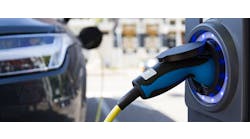Less than two months ago, Ford debuted its 2021 Mustang Mach-E, the company’s first all-electric SUV. And, a couple of days later, Tesla’s Cybertruck showcased for the world to see. It seems more and more companies are battling head-to-head to create an electric solution for transportation.
Now, roughly one in 250 cars on the road is electric—just over 2 percent of the entire vehicle market. In 20 years, however, that number will become the majority. According to BloombergNEF’s Electric Vehicle Outlook, 57 percent of all passenger vehicle sales will be electric by 2040. This means over the next two decades, worldwide EV sales are predicted to rise from 2 million in 2018 to 56 million. There are many signs that the EV takeover is upon us.
Gaining Momentum
According to Inside EVs, U.S. EV sales increased by 81 percent between 2017 and 2018, and it’s only growing from there. A 2019 Deloitte study forecasts EV sales shifting from 2 million units in 2018 to 21 million units by 2030. With these statistics in mind, automakers are now lining up to release their own set of electric vehicles. A total of 44 EVs are available in the U.S., according to EV Adoption (reported in December) and more are in the works for the upcoming decade. While EV models gain traction, so is the market for the batteries that power them. The EV battery market is projected to grow from $23 billion in 2017 to $84 billion by 2025—a CAGR of 17.2 percent. Overall, Deloitte says the market will reach a tipping point in just two short years.
The EV Spotlight
The 2019 Los Angeles Auto Show served as spotlight for EVs, namely the 2021 Ford Mustang Mach-E, which claims to go up to 300 miles per charge. The Mach-E is Ford’s attempt to compete with Tesla and shows that there’s becoming more mainstream adoption of EVs. The Associated Press even wrote a story (bit.ly/EVblitz) on how this vehicle marks the start of an EV blitz.
Not to be outdone by Ford, Tesla released its Cybertruck, which, according to Tesla’s CEO Elon Musk, already has 250,000 orders (ratchetandwrench.com/teslacybertruck). These two vehicles are grabbing the spotlight, but many other OEMs have released and plan on releasing EVs in the near future; the Audi e-tron, Mercedes-Benz EQC, BMW’s electric Mini Cooper and Porsche Taycan, to name a few. Jaguar Land Rover has said that its entire fleet of new vehicles will be electric or hybrid starting in 2020. BMW says that 12 all electric cars and 13 hybrids will be on the market by 2025 and GM will develop at least 20 new all-electric vehicles to launch by 2023. With more vehicles types and price models to choose from, consumers will have more EV options, which will increase their presence on the road.
Source of Power
With more EVs to drive, there’s a greater need for charging stations. ChargePoint, an EV charging network, is adding an average of more than 2,000 charging spots each month in 19 different countries. EVgo, another EV charging network that’s currently in 34 states, recently expanded its charging stations by 40 percent in California. The city of Los Angeles itself hopes to install 25,000 EV charging stations by 2025, up significantly from the roughly 2,000 it has today and New York announced a $250 million investment in DC Fast Chargers to be installed at JFK, according to a report by CleanTechnica. These are just a few initiatives that show companies and cities are gearing up for an increase in EVs on the road.
A Smaller Carbon Footprint
Rideshare companies are also starting to join in on the movement. Back in 2018, Uber unveiled a pilot program offering drivers cash incentives for driving EVs. Lyft recently joined in on the trend, too. In November, the rideshare company partnered with EVgo on its Express Drive rental program. The program, meant for Lyft drivers who rent rideshare vehicles versus driving their own, has added 200 electric vehicles for rideshare driver use throughout the Denver metro—the company’s largest deployment of EVs to date. And there are no plans to stop there; Lyft plans to add more and more EVs around the country every year. As a whole, rideshare’s popularity is hard to deny, so the fact that these companies are investing in EVs signals a trend.
Power Struggle
For many vehicle owners, the choice to own an EV is based on gas prices and the affordability of the vehicles. Right now, many EVs are out of the budget for many. However, if gas prices increase—which is largely determined by policies, such as emission standards—the cost to own an EV could soon be equal to or less than a gas-powered vehicle. Currently, the Trump administration is at odds with certain states (California, in particular) on fuel efficiency standards (reported in December). The final decision could impact the overall sales of EVs in the U.S., and is something to which shop owners should pay close attention.



